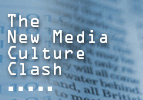



In her article, “Show, not tell: The value of new media scholarship,” Cheryl Ball differentiates between scholarship about new media in which print conventions such as written text are the main mode of argument; online scholarship in which print-based conventions are utilized, but the work is distributed online in a digital format such as a PDF file; and new media scholarship in which modes other than only written text (such as audio, video, images, and/or animation) are used to form an argument (2004).
She offers a “focused definition of new media as texts that juxtapose semiotic modes in new and aesthetically pleasing ways and, in doing so, break away from print traditions so that written text is not the primary rhetorical means” (2004, 405). Ball draws this distinction because she worries that lumping all three types of scholarship together inhibits the development of strategies for reading and interpreting new media compositions.
However, her definition — perhaps, her acceptance of the term itself — causes problems. First, by stipulating that the juxtaposition of semiotic modes be done in a “new” way, Ball highlights a conundrum. What constitutes a “new” application of semiotic modes? For how long is it new? If someone employs a particular juxtaposition of modalities, can no other composition that uses a similar strategy be considered new media? The use of the descriptor “new” in the term “new media” inherently complicates the label as soon as another technology or modality becomes available. Argument that could clearly be identified as “new media” one day could lack a clear classification the next because of the introduction of new software or hardware.
When the “new” gets old • In the eye of the beholder • Moving across the continuum • Works cited • Home